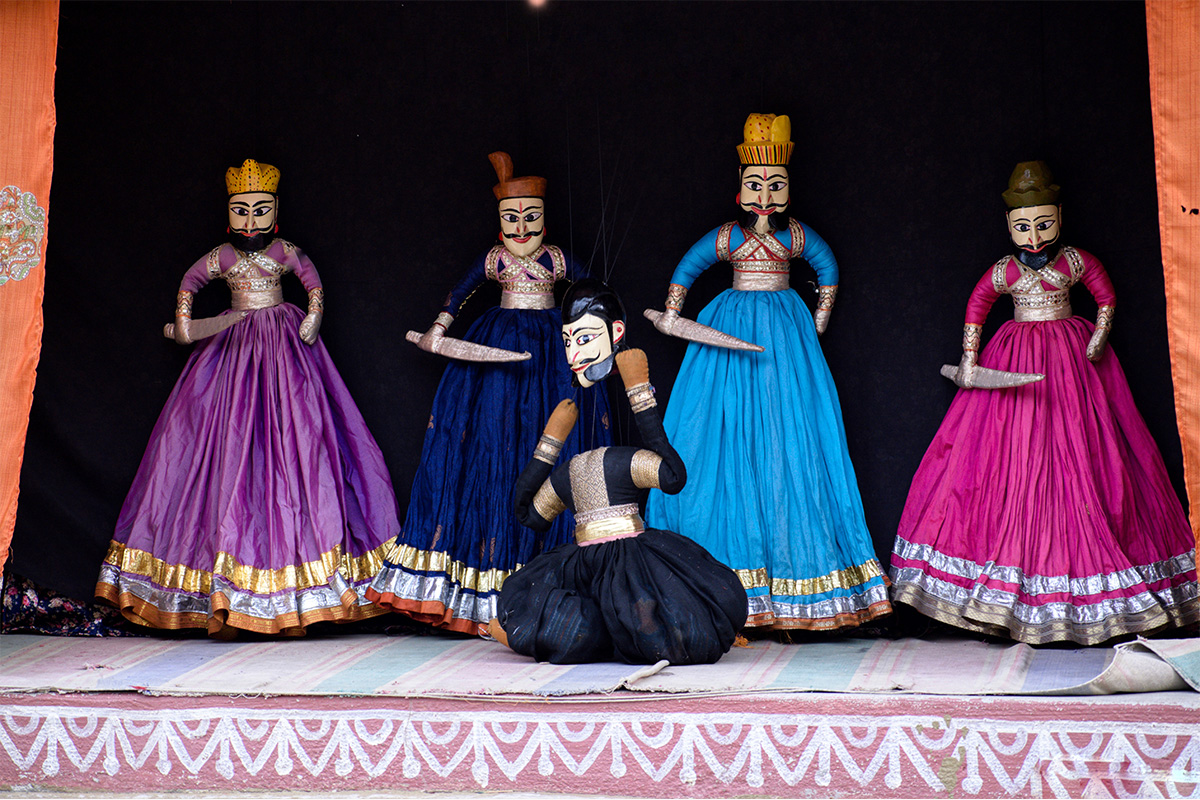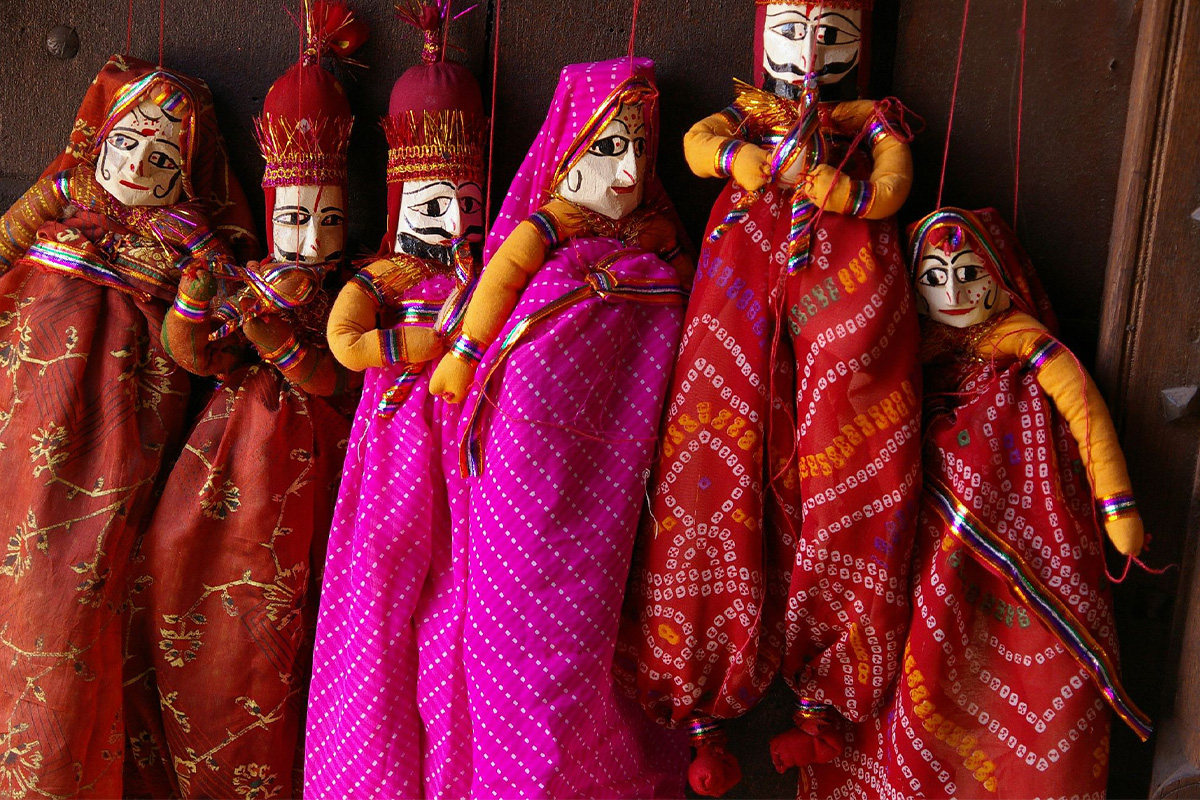ARTICLE
Kathputli
A form of string puppetry practised in the north Indian state of Rajasthan, Kathputli derives its name from katha meaning “story” and putli, which means doll. A Kathputli performance is also known as kathputli ka khel and, due to its distinct visual style, it is one of the most commonly recognisable forms of puppetry in India.
While the origins of Kathputli have not been clearly established, historical references suggest that the form has been practised since the seventeenth century. The puppeteers belong to the Nat Bhatt community and are from the districts of Nagaur, Churu and Sikar in north-eastern Rajasthan. The community traditionally lived an itinerant lifestyle: troupes, often composed of multiple members of a family, travelled from place to place to present shows before returning to their homes in the monsoon season to farm. Over time, some took up puppetry as their main profession and groups of puppeteers moved to cities such as Delhi, Mumbai, Ahmedabad, Hyderabad and Bhopal.
Traditionally, Kathputli puppets are between 1.5 ft to 2 feet in height. The head and trunk of a puppet is carved from a single piece of wood and often incorporates a headdress, such as a turban, for male characters. The torso, arms and hands are made by stuffing rags into the costume. These puppets do not have legs and feet: instead, the lower body is draped in a long trailing skirt and articulating in a manner that mimics the movements of legs. Additional props, such as swords or shields, are sewn directly onto the puppet.
A puppeteer may use between one to three strings to manipulate the puppet. The exception in this case is the puppet called rasdhari, a dancer who can have up to nine strings. The puppeteer does not use an aeroplane – a special control or clutch around which strings are tied – to manipulate the puppets. The strings are looped around the hand and fingers, and the movements of the fingers are used to articulate the movement of the puppet. Distinct iconography helps distinguish the puppets from one another: these can be expressed through the design of a puppet’s garment, or in the way facial characteristics, such as a beard, are painted. These facial characteristics are detailed and often evoke the visual style of Rajasthani paintings.
A traditional Kathputli stage is quick and easy to assemble: two charpoy or wooden cots are stood on end and covered with a dark cloth to form the backdrop. The puppeteers stand behind this cloth and work the puppets. The front curtain, made of painted or printed fabric, has arch-like openings and is called a Taj Mahal or a tibara. The stage is lit by kerosene lamps, or torches, placed on the ground at either end.
The repertory of kathputli performances – whose language is a mix of Hindi and Urdu – is not narrative in nature, nor is it predominantly religious. Instead, the performances are anecdotal and use episodes drawn from legends based on historical figures such as Amar Singh Rathore, Prithviraj Chauhan and King Vikramaditya of Ujjain. Within these performances, there is often an emphasis on the display of puppetry skills rather than the story itself. For instance, in a tale about the warrior king Amar Singh Rathore, a popular portion includes the appearance of nobles in a court where the time given to the puppets engaged in courtly entertainments such as horse-riding, juggling, swordsmanship and dancing may often exceed the time devoted to the plot.
A Kathputli troupe comprises the master puppeteer (also known as the sutradhar), an assistant, a bhagavat (singer-narrator) and musicians such as a drummer, a cymbal player and a harmonium player. The female members of the family might sing and narrate during the performance, but the master puppeteers are usually male and begin learning the techniques of puppetry at a young age. A distinguishing feature of a kathputli performance is the use of the boli. A voice modulator made by stretching a thin rubber tape between two sticks of bamboo, the boli is held between a puppeteer’s lips and is used to produce a whistle-like sound that denotes the speech of a puppet. The speech is then interpreted for the audience by a narrator also known as the jawaab denewala (“one who answers”).
In the 1980s and 1990s, Kathputli puppeteers were a part of the performance groups that travelled to several countries for the Festivals of India. Puppeteers such as Naurang Bhat and Puran Bhat were awarded by the Sangeet Natak Akademi for their contributions to expanding the repertory of kathputli theatre and for adopting modern forms and techniques. While Naurang Bhat worked closely alongside noted cultural revivalist Kamaladevi Chattopadhyay, Puran Bhat established the Aakar Puppet Theatre in the 1980s, which tackled social themes through the form of puppetry.
Despite its enduring popularity, however, Kathpuli has suffered a decline over the years. The pressures of keeping pace with other forms of entertainment and a changing audience have led puppeteers to reduce the duration of performances and move away from the traditional repertory. The puppets used today are also often greater in height and feature legs, limiting their articulation. Some puppeteers have taken to making and selling puppets as souvenirs instead, while others have turned to related professions and work as musicians or performing artists.
Bibliography
Our website is currently undergoing maintenance and re-design, due to which we have had to take down some of our bibliographies. While these will be re-published shortly, you can request references for specific articles by writing to hellomapacademy@map-india.org.








